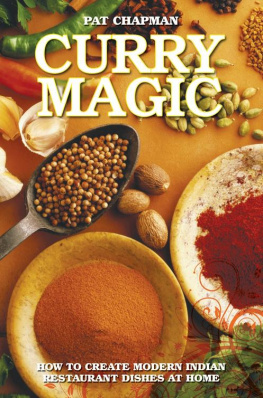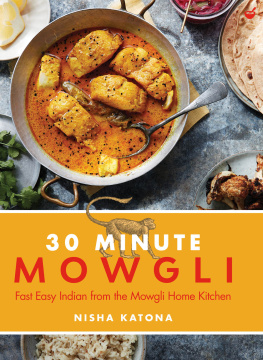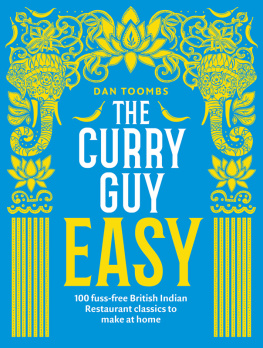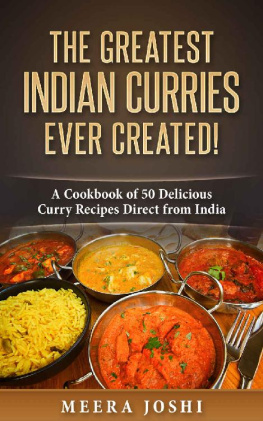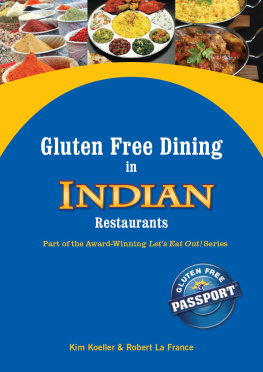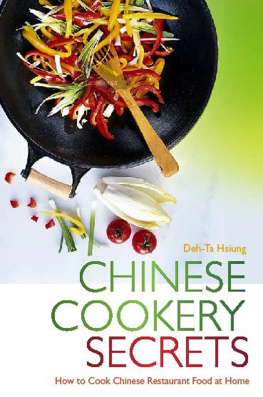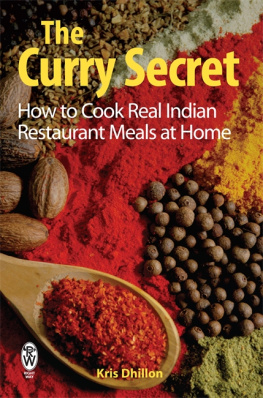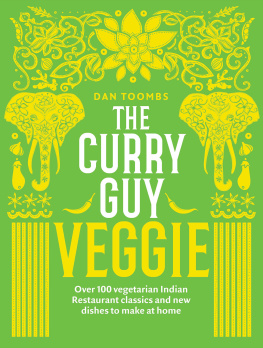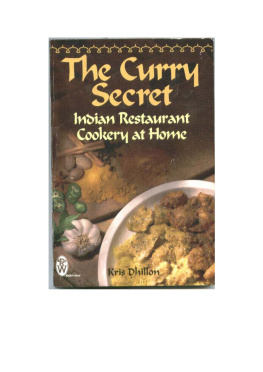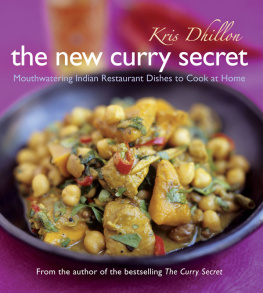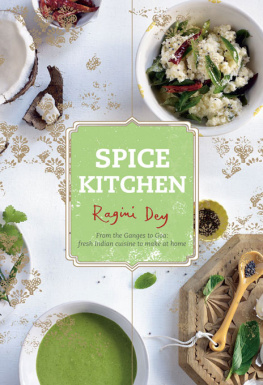It is now well over five years since I wrote my first cookbook, TheCurryClubIndianRestaurantCookbook, and in that time a lot has happened. I have learnt many new techniques and recipes. The Curry Club is now in its seventh year, and the growth and interest in Indian food generally has mushroomed. Madhur Jaffreys resoundingly successful TV series on Indian cooking has been repeated no less than five times; sales of ethnic products shot up as a result, and even the big multiples took notice and began to stock them. Many new curry restaurants opened, bringing new ideas to the trade. Not only was redflock wallpaper dispensed with in favour of light and airy furnishings and foliage, the standard heat-graded menu, with its choice of over a hundred curries, was also laid to rest by those restaurateurs who recognised a new awareness amongst their diners, in favour of a menu with a carefully selected choice of dishes.
Who could have predicted in 1948, when there were no more than six Indian restaurants in Britain, that 40 years on there would be 5,300? Over the last five years there have been 350 new openings a year and the trend shows no sign of deceleration at almost one per day, thats a lot of curry houses!
Every year a number of market surveys are carried out for the catering industry measuring trends and spending levels. For the curry restaurateur, these reveal nothing but good news. In 1987, for example, it was estimated that for the first time the number of Indian restaurants exceeded Chinese. The surveys found curry was the nations favourite dining-out food; that 2 million people ate a restaurant curry each week; that they had an average age of 24, and that they visited a curry house twice a month. The surveys show a steady growth in first time diners at curry restaurants, drawn not just from under 20-year-olds, but from all age groups, and they show that enjoyment of curry is not just a fad, it is here top stay.
Other surveys in the retail narket provide similar statistics. The overall sale of spices and Indian related products has grown from a trickle in the 1960s to a substantial amount. In 1987, around 25million was spent in the retail sector on spices (with curry powder being the best seller). Multiples and specialist stores bulge with products that would have been unimaginable a few years ago. Fresh exotic fruit and vegetables are flown in every day, and the choice of spices, herbs and basic exotic produce is nothing short of phenomenal. The British nation has become hooked on curry.
My first book TheCurryClubIndianRestaurantCookbook has done what it was intended to do. It contains most restaurant standard recipes and shows how to produce them at home. It also includes recipes which rarely appear in restaurants but which show useful techniques designed both to encourage the cook to do new things and to show the correct use of spicing. All of this information the 150 recipes, with the 30-page techniques introduction is basic and essential.
However, in the five years since I wrote it, Ive learned a lot more from the restaurants. Indeed, Ive had the privilege of working in Indian restaurant kitchens in Delhi and Bombay as well as some in London, working alongside the professionals. I want to share their secrets with you. What better way than by inviting the professionals to contribute recipes to the book. The selection of restaurants involved quite a lot of research. Armed with TheGoodCurryGuide, I made a short list of 200 restaurants, all the best in their particular field. I acquired their menus, then selected one or two particular dishes which looked interesting or special. That way I was able to select the widest possible range of recipes and there would be no repetition.
I was sure that some would not wish to give away their secrets. I was quite wrong, of course, as nearly all responded with promptness, generosity and sincerity, with carefully written recipes and enthusiastic approval and good wishes for my project. For the next few weeks, opening the post was really exciting. Reading the work of such experts was indeed a mouthwatering task as Im sure youll agree when you flip through these pages. Next came the task of selecting which recipes to use, and of re-writing them so that they would appear in uniform format. At the same time I tested them to prove that they actually worked. I have done this because it is a very different matter cooking for 20, 50, or 100 and more, to cooking small portions at home. As far as secrets are concerned, it is my belief that the better quality the resaurant, the less secrets they have. The owner or chef of a really good restaurant is not going to be frightened of losing custom because he gives away his recipes. If his cooking is good, he will always be assured of clientele, indeed the diner who succeeds in cooking a particular dish at home will return to that restaurant with greater appreciation and understanding of the skills required by the restaurant chef.
Some of the recipes came from restaurants and chefs continents away. A good number came from the sub-continent itself others from curry restaurants as far apart as Australia, Los Angeles, New York and Nairobi. Most are favourite restaurants within the British Isles.
I am most grateful to owners and chefs, to the management and staff of all the restaurants involved and hope they enjoy seeing their recipes in print. Above all I hope that you will enjoy trying out these recipes, hopefully learning new and exciting techniques and expanding your own curry cooking repertoire to match those of the very best restaurants in the world.
I hope your favourite dish is here, but if it doesnt appear in either book forgive me please. For I quickly found that it would have been very easy to add another 150 recipes for first-class speciality dishes from another 150 restaurants of equal quality enough for another book. But well just have to save these recipes until next time.
Pat Chapman
The Curry Club, Haslemere
Afghan Buzkash, London SW15
Agra, Warminster
Air India
Ameena, Birmingham
Asha, Liverpool
Ashoka, Belfast
Asia, Salisbury
Balaka, Hull
Beewees, London N4
Bekash, Milton Keynes
Bengal Lancer, London NW5
Blue Elephant, London SW6
Bombay, Norwich
Bombay Brasserie, London SW7
British Raj, Royston
Bukharra, Delhi
Chesham Tandoori, Chesham
Curry Fever, Leicester
Days of The Raj, Birmingham
Deansgate Tandoori, Manchester
Dewanian, London SE23
Dilruba, Rugby
Dilshad, Cleveland
Dilshad, Wolverhampton
Everest, Cardiff
Fishermans Cove, Madras
Fort Aguada, Goa
Friends Corner, Coventry
Ganges, Exeter, Plymouth, Torbay, Truro
Ganges, Bristol
Gaylord, London W1
Grand Indian, Bedford
Green Bengal, Birmingham
India, Folkestone
Indian Railways
Indus Curry, Colchester
Jamundi, London WC2
Johni Gurkas, Aldershot
Jhorna, Orpington
Kalpna, Edinburgh
Kathmandu, Manchester
Kensington Tandoori, London W8
Khyber, Plymouth
Kohinoor, Preston
Koh-i-noor, Newport, Gwent
Kutis, Southampton
Laguna, Leicester
Lake Palace, Udaipur
Lal Quilla, Liphook
Lancers, Edinburgh
Last Days of the Raj, London WC2
Light of India, Ilford
Light of India, Jersey
Madhus Brilliant, Southall
Magna, Bedford
Malabar, London W8
Mandalay, Leeds
Mandalay, London SE10
Mandeer, London W1
Manzil, Birkenhead
Miahs, Edinburgh
Mogul-e-Azam, Nottingham
Mughal Sheraton, Agra

